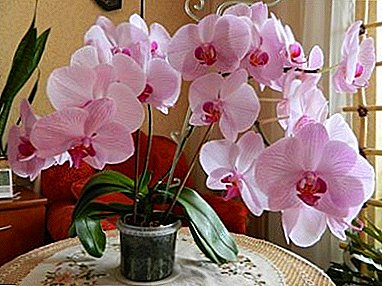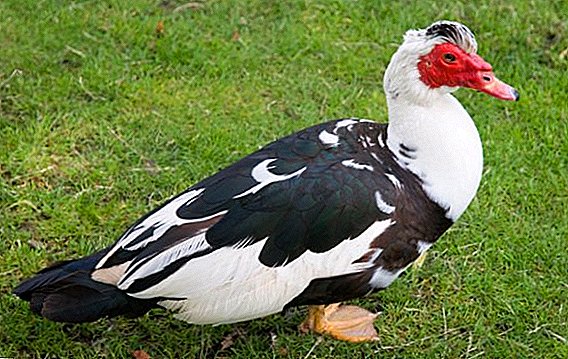
Delicate and incredibly beautiful pink Phalaenopsis can be seen in every flower shop and on home window sills.
Although lovers of these flowers can not even guess their origin and the presence of a huge history of breeding.
Pink orchid is not only the owner of a delicate shade, this species has spawned many varieties of equally attractive and elegant flowers.
What is this plant?
The peculiarity of this species are the rounded flowers of pale pink color.
Orchid grows on trees, but does not parasitize at the expense of their nutrients.. He likes well-ventilated soil, can grow on stones, crevices of rocks, as a rule, near water bodies.
Botanical characteristic
 Phalaenopsis look like grassy bushes, at the base of which are fleshy leaves. Green bush goes into a powerful root system, covered with a layer of wax. Due to the high content of chlorophyll when saturated with moisture, it becomes green.
Phalaenopsis look like grassy bushes, at the base of which are fleshy leaves. Green bush goes into a powerful root system, covered with a layer of wax. Due to the high content of chlorophyll when saturated with moisture, it becomes green.
Pink orchids, as a species, are small in size. It has dense leathery leaves located in rosettes. They have an oval-oblong shape and dark green color, although sometimes they are found with a reddish tinge. Sheet length can be up to 15 cm, and width - 8. As a rule, in the spring and autumn seasons 1-4 peduncles appear from the leaf sinuses.
Peduncle curved, has a dark purple color. Its length ranges from 25 to 30 cm. On one peduncle can grow up to 15 light pink flowersrosettes. They germinate one by one and reach 3 cm in diameter.
Color
By nature, Phalaenopsis has a white or white-pink color, sometimes with a slight shade of salmon color. Thanks to breeders who have long crossed different types of orchids, orchids and other shades of shades have appeared.
Earlier The most valuable were plants with a high peduncle and large white flowers.. Thus, the image of Phalaenopsis emerged, equated to a standard. This is a plant with flowers of medium size porcelain-white, pale pink or light purple flowers.
Later breeders brought varieties with flowers whose diameter could reach 15 cm. The natural elegance of orchids in hybrid plants of this variety was completely lost.
Views: description and photo
Pink orchids of this variety can be divided into 4 categories, two of which are classified as varieties, and the rest are hybrids:
- Schiller
- Stuart.
- Mini and midi.
- Hybrids.
Schiller

This is the most common variety of orchids of this species, the Philippines is its birthplace. The plants on the leaves have a silvery coating, which is dotted with dark green spots, combined in strips. Based on Schiller's orchids, most hybrids were created..
Schiller Phalaenopsis in hybrid varieties gives a huge number of flowers. Record recorded - 174 flowers on one peduncle.
Stewart

Almost identical to the Schiller orchid. Differs only branching peduncle and small flowers. They have a specific pattern - the rolling key of pink.
Mini and midi

Mini and midi orchids are notable for their compact size.. The height of the midi orchids can reach 40-55 cm, and the length of the leaf - 20 cm with a thick stem of 0.7 cm. Not all of them have a pink color, but some individuals still have a delicate shade.
Hybrids
Orchid varieties with exotic colors:
- Pink Dragon
- Pink Panther.
- Singolo pink.
- Pink cherry
- Grandiflora pink.
- Pink dreams.
- Royal terry pink phalaenopsis.
Appearance history
It is officially recognized that Phalaenopsis first pink orchid was found in the Moluccas by naturalist Rumph.who sent it to a familiar scientist in Britain. The flower has already reached dry, but the British nerd put it in the water. A week later, the first tropical pink orchid bloomed in the UK.
The scientist described the plant in the scientific work "Classification of flora and fauna." In it, Phalaenopsis was named "Epidendrum Adorable," that is, "living in trees."
Selection
 For the first time a hybrid of pink orchids was created in 1875 by John Ceden, the appearance of peduncles was noted in 1886. During this time, the company "Veitch and sons" was derived 13 more primary hybrids.
For the first time a hybrid of pink orchids was created in 1875 by John Ceden, the appearance of peduncles was noted in 1886. During this time, the company "Veitch and sons" was derived 13 more primary hybrids.
In 1920, the first large-flowered Phalaenopsis was created in France. And after 7 years, and the second, with large size and hard-outlined shape of a flower. In the 40th year, the Grex large-flowered orchid is created. It differed from its counterpart in a large number of flowers on the peduncle and in flat, dense, pure white flowers.
Only in the 50s high-quality grexes with pink flowers were obtained.. The basis was taken orchid with petals that have a pinkish tint on some parts and large-color hybrid. After 10 years, the direction of breeders has changed - a wave of creation of miniature Greeks has begun.
Care
Orchid is a capricious plant that requires strictly-defined conditions for maintenance:
- Temperature conditions. The plant requires at least 20oC in the winter and up to 35 in the summer. Lowering the temperature to 100 at night can kill a pink orchid.
- Location. Pink Phalaenopsis feels good on the windows facing east or west.
- Shine. In winter, the plant requires additional lighting with fluorescent lamps.
A pink orchid needs 12 hours of light to grow normally.
- Watering. Pink orchids require moderate watering. In the summer they are moistened as they dry - two or three times a week, in winter they reduce the volume to several times a month. Water must be separated at room temperature.
Top dressing
Pink orchid should be fertilized with complex orchid. It is added to the moistened substrate so as not to burn the root system. Busting up fertilizer can lead to cracking of leaves and lack of flowering. When choosing a fertilizer for a flower, you need to take a tool with the lowest nitrogen content.
Transfer
 Moss, pine bark, charcoal are used as a soil for pink Phalaenopsis.. Plants are planted in transparent plastic pots to monitor the position of the roots, monitor the need for moisture, and prevent the plants from dying.
Moss, pine bark, charcoal are used as a soil for pink Phalaenopsis.. Plants are planted in transparent plastic pots to monitor the position of the roots, monitor the need for moisture, and prevent the plants from dying.
Transplantation is performed only when absolutely necessary once every few years. The procedure is performed only after flowering. The bottom of the pot is covered with drainage. The shrunken roots are cut, the old soil is cleaned. The orchid is placed in a new pot and gently covered with substrate, without pressing it to the roots.
We offer to see a visual video about orchid transplanting:
Breeding
Subsidiaries can be separated during transplantation. Orchids can also be propagated by children that sprout on a flower. Young inflorescences appear approximately a year later..
Pests and diseases
- The most common problem of pink Phalaenopsis is root rot. Save the flower can timely pruning of affected areas, replacing the soil and reducing the amount of watering for the recovery period.
- Orchid is subject to attacks by aphids and red mites, which spread from a diseased plant to a healthy one.
When purchasing a flower, you need to carefully inspect the sheets and flowers, you can see on them the lesions from the mealy worm when infected with parasites.
Pink orchid rather capricious in the care of the plant. However, if all of the above recommendations are carried out on a home window sill, a flower “like a night butterfly” may bloom, which has pleased the eye of scientists botanists and ordinary inhabitants for more than one hundred years.












